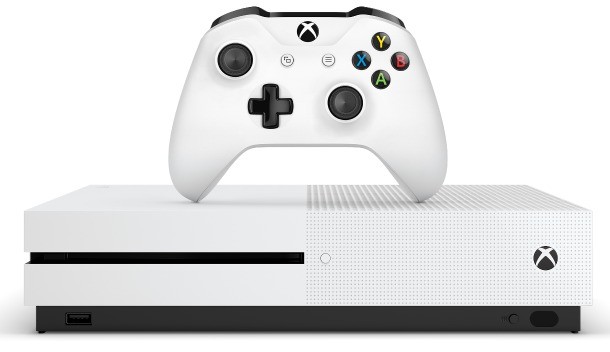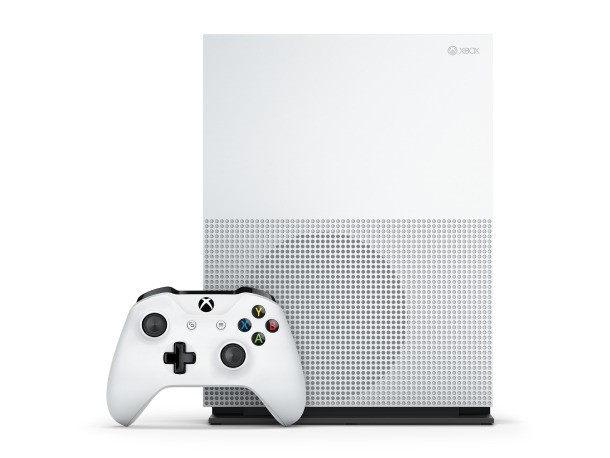Subscribe now to get the Vampire: The Masquerade – Bloodlines 2 issue and a D&D poster pack-in!
Xbox One S Review – Geared For A New Generation Of Entertainment

At this year’s Electronic Entertainment Expo, Microsoft announced two new consoles: Xbox One S, a smaller version of the existing Xbox One upgraded to support 4K media and high-dynamic range, and Project Scorpio, hardware Microsoft calls “the most powerful console ever.” The conversation following the press conference centered mostly on why Microsoft would announce two systems at once, leading people to question the need to purchase an Xbox One S when a better option is supposedly on the way next year.
After spending a weekend with Xbox One S, that question still looms large, and I unfortunately don’t have an answer, and won’t until we know more about Scorpio (and its price). Yes, I worry that I may be buying another Xbox One a year from now if Scorpio delivers any game-changing functionality, but as a new owner of a 4K TV, Xbox One S hit at the right time, and offers all of the 4K components needed to upgrade my home theater experience.
First and foremost, I needed a device that could take advantage of my new television's technology – 1080p just isn't good enough anymore. I needed a device that could give me great 4K playback. Xbox One S handles this task admirably, and is a hell of a value when stacked up against other options on the market. Similar to when PlayStation 3 launched alongside a field of pricey Blu-ray players (and ended up being one of the better values among them), Xbox One S doubles as one of the first Ultra HD Blu-ray players. For those of you not in the know, UHD is the next generation of Blu-ray discs, offering 4K video playback. I have not used any other 4K players extensively, but I’m told by trusted tech enthusiasts that the best (and only) UHD player people should consider outside of Xbox One S (which they haven't tested yet) is Samsung’s UBD-K8500, which retails for roughly $300.
While I'm not in a position to compare Xbox One S’s UHD player to the other options on the market, I watched three movies on its UHD player, and was blown away by the picture clarity. The color and contrast in the UHD version of Deadpool are nothing short of stunning, and yes, are a considerable upgrade over the 1080p version. I viewed Deadpool on Sony’s 65-inch 4K HDR TV (XBR-65X850D). I also took a look at J. J. Abrams’ Star Trek on UHD, and the fidelity difference is noticeable, particularly in smaller details like facial and fabric textures, and how colors pop in darker sequences.

The vibrant of color is tied to Xbox One S’s HDR10 support, which brings a better contrast between light and dark colors for all types of media – including all games played on the console. The Xbox One upscales games to 4K, offering sharper contrast and color ranges. Performance, as I could tell, was not affected in any way for any game. I tested a dozen-plus titles and didn’t encounter any visual or framerate problems, just a better picture. Even the dashboard is presented in 4K.
The gains in picture quality are obviously greater on larger displays. I wouldn’t call myself a home theater enthusiast, but I’m impressed with Xbox One S's 4K functionality. The leap in technology isn’t as great as DVD to Blu-Ray, but I doubt we'll ever see a shift in quality to that degree again. The one downside: UHD Blu-Ray discs are expensive, retailing on average for $29.99 or more. Streaming services like Netflix offer 4K support, which again I thought looked great on the Xbox One S, but the quality will obviously vary if your Internet can't handle the data.
For people who travel with their consoles and/or don’t have a lot of shelf space available, the Xbox S is 40 percent smaller than its large predecessor, and best of all, is equipped with an internal power supply. The days of lugging around a power brick are over; the only thing you need now is a small cable and the stand, if you want to place it vertically. Microsoft also moved one of the Xbox One's three USB ports (and the pairing button) to the front of the console for ease of use.
The back of the console is missing one significant component that was included in the original Xbox One: A Kinect port is not included. People who still want to use Kinect must purchase a sizeable adapter, which plugs into a power source. Those upgrading from an original Xbox One can request one at no cost from Microsoft provided they have both console serial numbers. Funny how Kinect was viewed by Microsoft as a necessary gaming component just a few years ago, and now it doesn't even work out of the box with the newer console model.
Each Xbox One S ships with an enhanced version of the Xbox One wireless controller, the best controller in the business. This slightly tweaked model offers a new textured grip, and an updated thumbstick that supposedly reduces wear (but doesn't feel too much different). The changes are subtle, but are welcome additions, especially if the grip on the analog sticks doesn’t wear as quickly. This controller also offers twice the wireless range as its predecessors (which I doubt anyone will use), and is equipped with a Bluetooth radio, should you want to connect the controller to other devices. The Xbox One S hardware also features an IR blaster, which can be configured to turn on other devices, limiting the need for other remotes.
Right now, the only Xbox One S option on the market is the 2TB version, retailing for $399 (complete with a 14-day Xbox Live trial). Later in the month, Microsoft is releasing a 1TB alternative for $349, and a 500GB version for $299. All three versions are only available in the “robot white” color at launch.
The question remains: Should you purchase an Xbox One S? If your Xbox One works fine, and you don’t have a 4K TV, ignore it for now and keep your eyes on the horizon for Scorpio. The 4K playable options won't do anything for you. Conversely, if you have a 4K TV and you truly want to take it for a spin, the Xbox One S pairs perfectly with this new technology.













